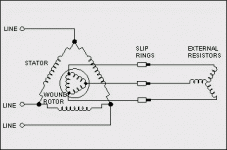Hello,
I have an application where I need to have a motor drive a load into a parked position and keep it there until brakes can set and hold it in that position. The motor controller is just a regular full voltage reversing starter.
With a drive I can have the drive output at a reduced torque. However, for an across the line controlled motor how can I press the load into place without having the motor go into locked rotor current and trip out. We are talking maybe 3-5 seconds of pressing/holding till the brakes set.
I am thinking about all sorts of delta wye starters or introducing some large power resistors into the lines of the motor in series.
I have an application where I need to have a motor drive a load into a parked position and keep it there until brakes can set and hold it in that position. The motor controller is just a regular full voltage reversing starter.
With a drive I can have the drive output at a reduced torque. However, for an across the line controlled motor how can I press the load into place without having the motor go into locked rotor current and trip out. We are talking maybe 3-5 seconds of pressing/holding till the brakes set.
I am thinking about all sorts of delta wye starters or introducing some large power resistors into the lines of the motor in series.

